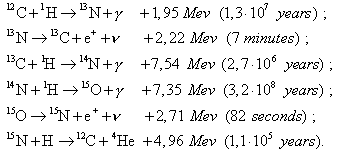V.5 No 1 |
13 |
| Chapter 2. Hypothesis of origin of planetary system (part I1) | |
|
|
V.5 No 1 |
13 |
| Chapter 2. Hypothesis of origin of planetary system (part I1) | |
|
|
"The second branch of proton-proton reaction begins with the combination of 3He nucleus with the nucleus of trivial helium 4He, after which the nucleus of beryllium 7Be is produced. The beryllium nucleus can, in its turn, catch a proton; after this, there forms the nucleus of boron 8B, or can catch an electron and turn into the nucleus of lithium … Finally, last, third branch of proton-proton reaction includes the following chains: 7Be after having caught an electron turns into 7Li which, having caught a proton, turns into unstable isotope 8Be… " [1, p. 131- 132] (see Fig. 2.44).
|
|
| Fig. 2.44. Diagram of the star with "two-layered" source of nuclear energy [1, p. 186, Fig. 61]. At different levels of star nucleus there occur nuclear reactions of different type and produce different chemical elements
|
We see from the equations that in the course of these reactions there releases tremendous energy, and the density in the star centre makes difficult to remove this energy. Consequently, in the centre of star even more heating up occurs and creates the conditions for a very energy-consuming carbon-nitric cycle, which, by calculations, requires the temperatures of ninth order: |
 |
(2.5) |
.[1, p. 132, Table 2]. The further synthesis goes as follows: |
 |
(2.6) |
[11, p. 145]. The fundamental question is here, does the substance of stellar depths mix with it? If yes, the synthesis has to go on, but with the substance exchange, there has to occur the heat removal decelerating or fully stopping the nucleosynthesis (in case of effective removal). If the substance does not mix, when hydrogen was depleted, nucleosynthesis has to stop. Here the scientists' opinions are strongly controversial. Some believe, we may not state the possibility of deeper synthesis than proton-proton reaction, others consider further production of heavier nuclei; some consider nucleosynthesis as a continuous process, others - as discrete, and draw different versions of this intermittent process. In such version it is supposed that at each stage there in the nucleus not only the initial element burns out, but the nucleosynthesis stops, and pressure and temperature necessary to continue synthesis at higher level fall. This supposition of intermittent process impedes to consider further evolution and makes researchers to introduce different artificial suppositions like following: "The calculation shows, to the time when 24Mg is produced, helium in the depths of star is exhausted. Since 'nuclear fuel' is deficient, the pressure in the depths decreases and nucleus is contracted again. Contraction causes the abrupt temperature growth. At temperatures of three billion degrees order (!), the atomic nuclei created before already react and produce even heavier nuclei, mainly iron 56Fe. Atomic nuclei with more atomic weight also produce, but they are unstable and fast decay out. So we can think the star nucleus consisting of iron" [11, p. 145]. |
Contents: / 1 / 2 / 3 / 4 / 5 / 6 / 7 / 8 / 9 / 10 / 11 / 12 / 13 / 14 / 15 / 16 /